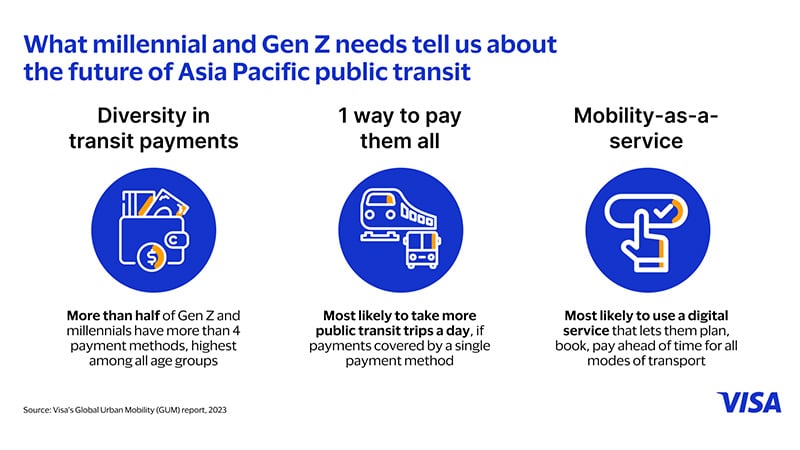What Millennial and Gen-Z needs tell us about the future of public transit

Gen-Zs and millennials, expected to make up half of Asia Pacific’s population by 2025,1 are becoming influential by the day. Their preferences, values, and behaviours will eventually shape the way society does everyday things, including how people move around in cities.
For example, in Vietnam, Gen Z will make up a third of Vietnam’s workforce by 2025,2 and this tech-savvy generation together with the millennials who came before them will account for around 40 percent of consumer demand in the country by 2030.3 This represents significant economic sway in one of Asia Pacific’s fastest-growing markets.
What do Gen-Zs and millennial commuters want?
As digital natives, millennials (born between 1982 and 19974) and Gen-Zs or “zoomers” (born from 1998 onwards) are much more comfortable with paperless transactions than earlier generations, and are increasingly adopting a cashless lifestyle.5 For instance, Visa’s Consumer Payment Attitudes Study shows that Southeast Asia’s zoomers and millennials have been more successful in going cashless than Gen-Xers or boomers.6 Indeed, the embrace of digital transactions by this new generation of consumers helped usher in the recent boom in e-commerce and boosted the popularity of ride-hailing services in the region.7
No wonder then that payment methods have become a key deciding factor for millennials and zoomers when it comes to mobility, especially when taking public transportation. Visa’s Global Urban Mobility Survey, conducted by Wakefield Research, found that zoomers and millennials – over half of whom currently use more than four payment methods, the highest among all age groups – are most likely to take more public transport trips if they can pay for all modes of transport using just one payment method.
And, if given the choice, they are most likely than other age groups to use a one-stop digital service to plan, book, and pay ahead for all modes of transport. In other words, what millennials and zoomers want is an all-in-one solution – the freedom to go anywhere the way they want, and pay for transport in a single, unified way.
Everything, everywhere all at once: reimagining transit and payments
Enabling the kind of unified payment method that Gen-Zs and millennials desire and providing access to numerous transport choices on one digital platform requires a shift in the way the public sector approaches transportation. This, in turn, requires collaboration among transit agencies and operators, and industry players, such as banks, payments specialists and app developers, putting technology at the heart of national or city-level mobility strategies.
Key to this is the adoption of open-loop systems, which accept payments from credit or debit cards across different modes of public transport. All commuters have to do is to tap their contactless cards or mobile wallets to access their preferred modes of public transport.
For example, India has launched the National Common Mobility Card, which works on metro systems, suburban railways, and bus networks.8 In Vietnam, Visa has worked with the transport department of Ho Chi Minh City, the country’s biggest city, to implement contactless tap-to-ride payments in the city’s buses.9 These efforts bode well for the future of mobility for these countries’ large Gen Z and millennial populations. Even in ageing Japan,10 rail companies have started to introduce contactless payments using credit cards, primarily targeting international visitors.
Recent developments in urban mobility include local platforms that integrate some services like planning, booking, and payments into one app. Examples include SimplyGo in Singapore that allow users to plan routes and manage payment cards and top-ups, and local route planning apps like Arevo in Australia and Navitime in Japan. These are a step towards MaaS by delivering more efficient and seamless commuting experiences while easing urban challenges, such as traffic congestion and climate change – a win-win for commuters, transport authorities and urban planners.
Open-loop systems have far-reaching benefits beyond just interoperability. They can also provide transport operators with more real-time data to stay on top of evolving demand trends so they can continually develop more precise and effective commuter-focused solutions.
Moving the next generation around and forward
If the future of Asia Pacific’s workforce are millennials and zoomers, then the future of public transit is open, flexible, and digital. That’s why Visa has been involved in urban mobility projects in 640 cities globally and 50 cities in Asia Pacific11 to support transport agencies and operators, many of whom are government-owned, to make the transition from legacy closed-loop systems possible.
Each country may have a different approach to going digital, but adopting global payments standards like Visa’s will make it easier for their transit agencies and operators to implement smart solutions like MaaS. We leverage the best practices from our engagements worldwide to develop cutting-edge solutions that are responsive to the unique demands of zoomers and millennials across Asia Pacific.
Staying a step ahead of the evolving public transportation needs of millennials and Gen-Zs – and succeeding generations – may be a challenge for even the nimblest of transport authorities, but private sector partners can offer their expertise and experience in harnessing the power of technology to help current and future generations take public transit into the future.
Visit the Visa Global Urban Mobility website for the latest mobility insights in Asia Pacific.
2 https://www.pwc.com/vn/en/publications/2021/pwc-vietnam-digital-readiness-genz-en.pdf; https://vietnamnet.vn/en/visa-reports-on-the-rise-of-vietnam-s-digital-banking-2185923.html
3 https://www.mckinsey.com/featured-insights/future-of-asia/the-new-faces-of-the-vietnamese-consumer
7 https://www.grab.com/sg/press/consumers-drivers/singapore-millennials-seek-experience-led-offerings-on-lifestyle-app-grab/; https://www.thejakartapost.com/ms/gojek-2019/2019/07/30/gojek-most-used-mobile-app-among-millennials.html
9 https://vir.com.vn/visa-renews-partnership-with-ho-chi-minh-city-department-of-transport-100029.html